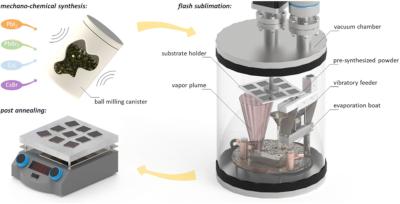Researchers at NREL, BlueDot Photonics, University of Washington, Colorado School of Mines and Rochester Institute of Technology have developed a vapor deposition technique based on continuous flash sublimation (CFS) to fabricate all-inorganic perovskite thin films in under 5 minutes in a continuous process. The adoption of the proposed approach may also result in higher power conversion efficiencies of perovskite solar cell.
Schematic illustration of the continuous flash sublimation (CFS) approach consisting of a mechano-chemical synthesis of the source powder (here CsPb(IxBr1−x)3), the high-throughput deposition process in a home-made evaporation system, and a short post-annealing treatment to improve thin-film quality. Image from Journal of Materials Chemistry A
The team described the new technique as a non-batch process that solves two problems associated with the use of established vapor processing in perovskite material manufacturing – the slow speed of deposition and the non-continuous nature of batch processing.
The scientists explained that not only does their novel approach allow for the continuous deposition of a fully absorbing perovskite material within less than five minutes, but solar cells prepared with these materials also outperform previously realized efficiencies of vapor processed inorganic perovskite solar cells.
The researchers said that they are pursuing vapor processing because of its potential for high yield, high-quality and high reproducibility processing, and its potential to eliminate the use of hazardous solvents. Furthermore, it is seen as simplifying the scaling up to larger device areas. In addition, its performance on rough surfaces makes it attractive for perovskite-based tandem applications.
The scientists fabricated a variety of “high-quality” cesium lead halide (CsPb(IxBr1−x)3) thin films in a prototype system to test the versatility of the CFS approach, noting that the process was able to produce thin film compositions “across the entire bromine/iodine space maintaining the composition of the source materials”.
The CFS-derived films were made into working solar cell devices. The study’s champion solar cells achieved power conversion efficiencies as high as 14.9%, open-circuit voltage of 1.17 V, fill factor of 76.0%, and short-circuit current densities of 16.8 mA cm−2. The forward scan direction values were 10.3%, 1.12 V, 55.1%, and 16.7 mA cm−2, respectively.
In their recent work, the researchers describe the source material, a mechano-chemically synthesized powder, and how it is prepared by mixing individual precursor materials, cesium and lead salts into a stochiometric powder. They said it was flashed at high temperatures to overcome the differences in deposition characteristics of the individual precursor materials.
The powder was filled into a reservoir connected to a vibratory feeder, which in turn was connected to an AC signal. After moving along the vibratory feeder, the powder falls into a preheated tantalum evaporation boat kept at a temperature “significantly above” the highest sublimation temperature of the individual inorganic salts, typically in the range of 700 C. “Inside the evaporation boat, the powder constituents instantaneously sublime, leave the evaporation source, to finally condense on a substrate situated above the evaporation boat,” explained the team.
An annealing step at temperatures between 330 C and 380 C for 0.5 min to 1 min was implemented after the CFS step to “improve thin-film quality and to ensure stabilization of the correct photoactive perovskite phase”.
The team concluded that the work is a critical step toward fast and continuous processing of perovskite materials, which is “highly suitable for the fast deposition of thin films whose individual constituents have significant differences in sublimation characteristics.”
In the future, the CFS method could also be used for other hard-to-deposit material classes, as well as investigating using this method with other types of perovskite materials, such as hybrid materials containing organic and inorganic precursor materials.


